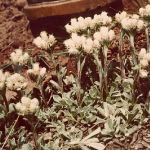| Common Name: |
Catsfoot |
| Other Names: |
Pussy-toes, life everlasting, cat's ear |
| Botanical Name: |
Antennaria dioica |
| Genus: |
Antennaria |
| Family: |
Asteraceae |
| Native Location: |
Europe, N America, N Asia |
| Cultivation: |
Well-drained soil in sun. |
| Propagation: |
By seed sown in spring; by division in spring. |
| Harvest: |
Whole plants or flower heads are cut before the flowers are fully open and dried for use in infusions. |
| Variations: |
Nyewoods
Has a compact habit and pink flowers
Width: 20cm (8in)
Rosea
Has pink flowers
Height: 10-15cm (4-6in)
Width: 25cm (10in) |
| Height: |
5-20cm (2-8in) |
| Width: |
25-45cm (10-18in) |
| Hardiness: |
Z5-9 |
| Parts Used: |
Whole plant, flowers |
| Properties: |
An astringent, aromatic herb that has diuretic effects and stimulates the liver and gallbladder. |
| Medicinal Uses: |
Internally for liver and gallbladder complaints, hepatitis, and diarrhea. Externally as a gargle for tonsilitis and a douche for vaginitis. |
| Bibliography: |
Encyclopedia of Herbs by Deni Brown Copyright © 1995, 2001 Dorling Kindersley Limited Pg 123 |
